Description
Tropical Palms – 10 tropical palms and palmlike species in 3 variants, 3 ages and 4 seasons each, for architects and CG artists working in 3ds Max, Cinema 4D, or Houdini. (360 different tree shapes in total). A variety of Renderers are natively supported, such as Cinema 4D Advanced Render, V-Ray, Corona Renderer, Thea Render, Octane Render and mental ray.
A spectacular collection of tropical species found across the tropics, growing and planted at beaches, streets, parks, and gardens. Laubwerk Plants Kit 7 includes the coconut palm – the symbol of a tropical island paradise, the travelers palm – one of nature’s most distinctive and remarkable plants, and the Vanatu fan palm – one of the most interesting and elegant of all small palms.
System requirements:
-Autodesk 3ds Max or 3ds Max Design (2010-2016), MAXON Cinema 4D (R12-17 Mac & Win), Sidefx Houdini (13-14)
-Additionally, Python (on Windows) for customers to build their own importers into applications compatible applications compatible with Python 2.2, 2.7, 3.3, or 3.4.
-A computer that is capable of running your version(s) of 3ds Max, Cinema 4D, or Houdini.
-10MB of hard disk space and additional space for the Laubwerk Plants models.
What will you get after purchase?
You will receive a Coupon Code from us, enabling you to download this package from the Laubwerk-Website for free. The complete file size is a bit less than 1 GB. To download you have to register at the Laubwerk Website. This will allow you to download and update this product directly from the manufacturers website whenever necessary. The purchased license is an ‘Per Artist’ license. Additional render nodes are free of charge!
These trees are included:
ALEXANDER PALM
Archontophoenix alexandrae
Tall, fast-growing, solitary palm with a majestic crown of 6-10 arching pinnate fronds. Light grey, smooth stem with prominent annulated leaf scars, trunk base usually swollen or bulging, crownshaft pale glaucous green. Large, stiff feather leaves consisting of numerous closely spaced narrow leaflets pointed at the tip, dark green above and whitish or ash-colored beneath. Numerous white or cream flowers, arising below crownshaft. Small, round fruits, pale yellow turning bright red when ripe. Popular ornamental palms in the tropics and subtropics due to the graceful and majestic appearance.
BETEL NUT PALM
Areca catechu
Medium-sized, solitary palm tree with an narrow, upright habit and arching, semi-erect fronds. Slender and errect stem with prominent annulated leaf scars and a green crownshaft. Broad, glossy green, feather-shaped leaves pinnately-compound with numerous, crowded leaflets, with a few of the lowest leaflets often hanging. Multiple-branching spadix, creamy-white, sweet scented flowers emerging from below the crown shaft. Fruits are ovoid drupes (betel nuts) turns orange-yellow when ripe. The palm is grown primarily for betel nuts.
COCONUT PALM
Cocos nucifera
Large, solitary, slender palm with a vigorous crown of pinnate feathery fronds growing from the apex. Tall, slim, grey trunk prominently ringed with old leaf scars. Large, pinnate fronds, ascending to spreading to drooping, consisting of linear-lanceolate, rigid, yellowish-green to dark green leaflets. Old leaves break away cleanly, leaving the trunk smooth. Flowering occurs continuously. Flowers are cream to yellow, arising from within the lower fronds. Fruits ovoid drupes ripening from light green or yellow to brown. Recognized by people throughout the world as the embodiment of the tropics of lush, tropical paradises with sandy beaches. Nowadays, almost ubiquitous tropical palm between 26°N and 26°S except for the interiors of Africa and South America.
LIPSTICK PALM
Cyrtostachys renda
Slender, clustering palm with up to about 3 or more adult stems and a shuttlecock-shaped crown. Scarlet to bright red crownshaft. Stem green with greyish stripes or yellow with greenish and purplish stripes. Pinnate, alternately-arranged, erect, stiff leaves, up to 8 per crown, with red stalks consisting of boat-shaped, light to dark green leaflets, slightly grey on the underside. Its bright scarlet crownshaft and petioles, red as sealing wax, make this palm one of the most attractive of palms. Widely cultivated ornamental for tropical regions. This palm is the symbol of the Singapore Botanic Gardens.
YELLOW CANE PALM
Dypsis lutescens
Small to medium-sized, slender, clumping palm with multiple cane-like stems emerging from the base and gracefully arching outward and downward pinnate fronds. Smooth, greyish-green stem ringed with distinct leaf scars and yellowish-green crownshaft. Yellowish-green to bright green, soft leaves with a prominent elevated midrib and lanceolate leaflets. Panicles of yellow flowers at the base of the crownshaft. Small, asymmetric, oblong fruits ripening from yellow to purple. Grown as an ornamental plant in gardens in tropical and subtropical regions, and elsewhere indoors as a houseplant. The palm has gained the Royal Horticultural Society’s Award of Garden Merit.
VANATU FAN PALM
Licuala grandis
Small, solitary palm with very distinctive fan-like, regularly pleated, circular fronds. Thin, fiber covered trunk. Glossy, deep green, undivided leaves with notched tips. Inflorescence emerges from among the leaves with clusters of yellowish white blossoms. Green, rounded, small fruits turn red when ripe. Perhaps one of the most interesting and elegant of all small palms, ideal for understories in small, tropical landscapes as well as interiorscapes.
TRAVELLER’S PALM
Ravenala madagascariensis
Medium-sized, single-stemmed plant with a unique symmetrical fan-shaped crown. Sturdy grey trunk woody-like with showy leaf scar rings. The trunk is hidden underground in juvenile plants with the fan of leaves sitting on the ground and emergent in mature plants. The enormous paddle-shaped, deep green leave blades are borne on long petioles and in a distinctive fan shape aligned in a single plane. Leaf margins are sometimes split. Multitudes of small creamy white flowers. Mature palms may bloom year round and produce brown fruits that contain light blue seeds. Not a true palm, but more closely related to Strelitziaceae (bird of paradise). One of nature’s most distinctive and remarkable plants. In tropical and subtropical regions, the plant is widely cultivated for its distinctive habit and foliage, e.g. popularly used by hotels and condominiums to give a lush tropical feeling.
CARIBEAN ROYAL PALM
Roystonea oleracea
Large, majestic palms with eye-catching crown of ascending to spreading graceful feathery fronds. Grey to whitish-grey, smooth, erect trunk, usually with a distinctive bulge at the base, clearly demarceated green crownshaft. Very long, waxy, pinnate, bright green leaves, ascending to spreading, drooping slightly at the tip. Inflorescences cream, large and branched arising from below the crownshaft. Small, oblong fruits changing to purplish-black when ripe. The tallest and “most majestic” royal palm is often used as an ornamental.
CABBAGE PALM
Sabal palmetto
Medium-sized, sturdy, distinct fan palm topped with a symmetrical, very dense, round crown. Gray, rough, fibrous trunk, quite variable in shape, from straight and erect, to curved or leaning, old leaf bases (“boots”) create a criss-cross pattern, trunk gets smoother as the palm matures. Large, costapalmate type leaves (mix of palmate and pinnate) with range in color from bright green to deep olive green growing right from the trunk spreading in all directions because there is no crownshaft. Small creamy to white, fragrant flowers that droop in clusters from within the crown. Black, edible fruits are fleshy, drupelike berries. Popular landscape plant known for its tolerance of salt spray and cold as well as being hurricane-proof.
FOXTAIL PALM
Wodyetia bifurcata
Small or medium-sized solitary palm with a delightful crown of gracefully arching fronds. Light grey, smooth, slender trunk, closely ringed, bottle shaped to columnar, slightly swollen at base, green, slender, narrow crownshaft. Bushy, light green, fine, narrow leaves, leaflets radiate out of all angels from the leaf stem, giving it a characteristic foxtail or bottlebrush appearance. White blossoms emerging at the base of the crownshaft. Oval-shaped fruits clustered, ripening from green to orange-red. One of the most spectacular foliage displays of all palms.



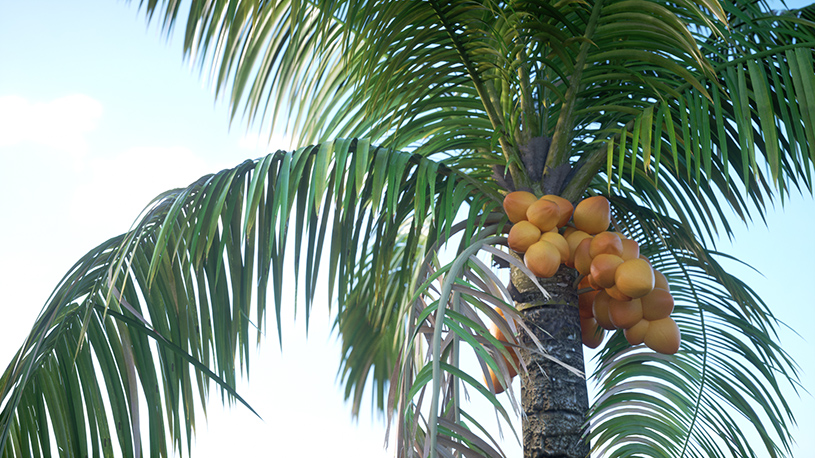


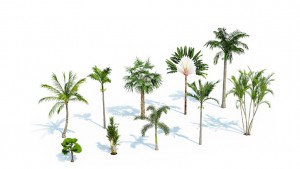
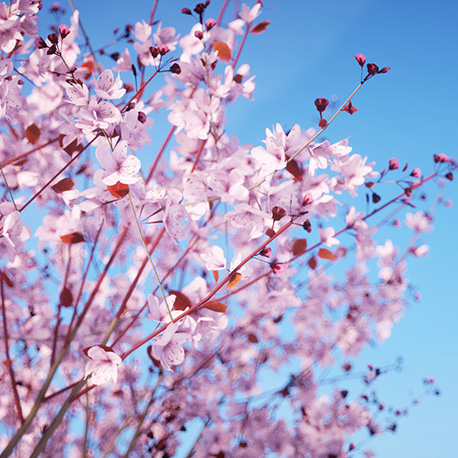

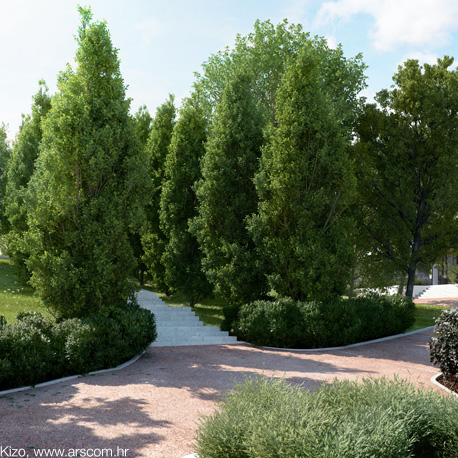

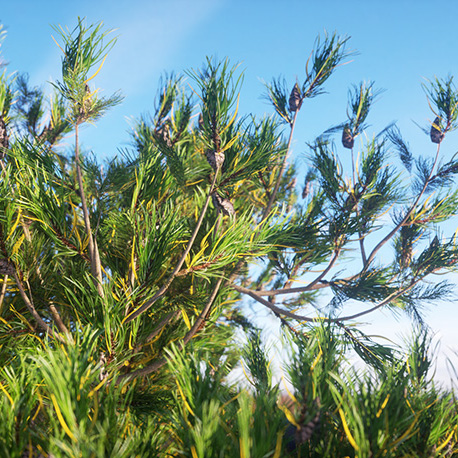





Reviews
There are no reviews yet.